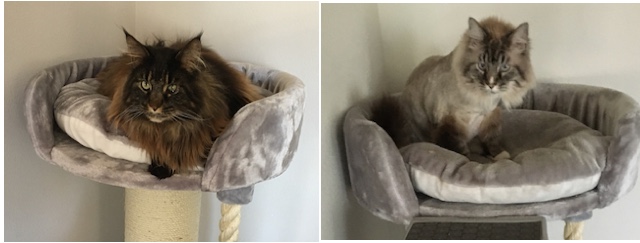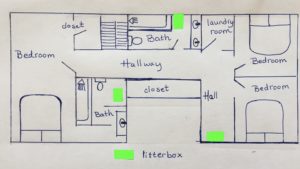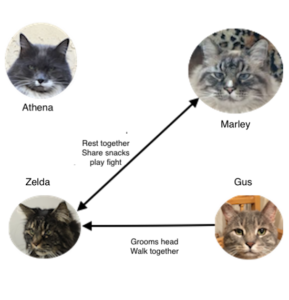How Cats Get Along – Timesharing
Sharing Resources
If there is plenty of food around, free-roaming cats often form groups called colonies. Within the colony, there are smaller social groups of 2 or more cats that prefer to spend time together. Cats belonging to a particular social group, will share food, water, latrine areas, sleeping and resting places.
Timesharing in the Cat Colony
Cats in different social groups tend to keep their distance from each other. How cats get along is to “timeshare” or “take turns” using essential resources such as resting areas and feeding stations. When one social group is done, another cat or group of cats will move in to use the resource.
Timesharing in the Multi-Cat Home
Like cats in a colony, cats in a multi-cat home timeshare resources. You may notice that different cats will occupy a particular favored resting place at different times. If you watch carefully, you may see a cat watching this place, waiting for the resident cat to vacate the space, before moving in to use the space.

If there are enough beds, litter boxes, etc. available, this system usually runs smoothly. But if too many cats want the same thing, bickering can occur and more dominant cats may push other cats away from these resources. How cats get along in an outdoor colony may be to vote with their feet and move on – indoor cats do not have this option.
Cat society does not have a rigid hierarchy – there is no alpha male or female. There are simply some cats that have more dominant personalities. Unlike dogs, where a lower-ranking dog will surrender the prize to a higher-ranking dog, cats don’t have a hierarchy that dictates who gets what.
If a fight arises between cats over resources, the relationship between the cats involved may be damaged – they may not be able to tolerate each other after this. Needless to say, if the contested resource is a litter box, cats may be forced to find other places to eliminate and we, as caretakers, will not be happy.
In this video, 3 cats have worked out a way to avoid fighting over the nighttime treats. While not timesharing, the video shows resource sharing set up by cats.
Owner Managed Timesharing
If the cats are unable to timeshare resources on their own, we must set this up for them.
Setting up a Timesharing Plan

Map out locations of the primary resources: feeding stations, litter boxes, resting places, scratching posts

Are there enough feeding stations, litter boxes, beds, scratching posts? The rule of thumb is (#cats +1) or (#social groups + 1)
Are resources separated enough so that cats of different groups can access them?
Can access to these resources be blocked by another cat?
Is there enough room for cats from different social groups to pass each other “out of paw-swipe”?
If resources cannot be spaced appropriately and conflict continues, you may need to keep one social group in another part of the house, while the other is using the main area. Have different social groups use critical areas in shifts. Slow, planned re-introduction may be possible between cats who “have fallen out” with each other. Introducing Cats: A Short Guide


